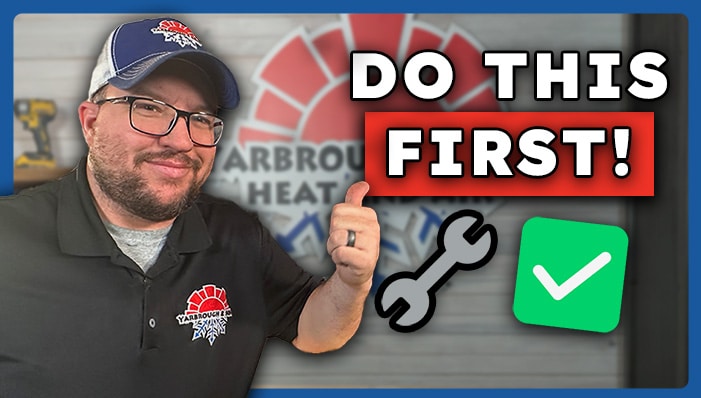How to Avoid an HVAC Service Call: DIY Tips Every Homeowner Should Know
Homeowner Tips & News
Family Owned & Operated
Trusted & Highly Rated Service
Responsive & Timely Service
How to Avoid an HVAC Service Call: DIY Tips Every Homeowner Should Know

At Yarbrough & Sons Heating, Cooling & Plumbing, we believe in empowering homeowners with the knowledge to care for their HVAC systems and avoid unnecessary service calls. Many common issues can be easily addressed with a few simple steps—saving you time, money, and the hassle of a technician visit. By following some DIY tips, you’ll be able to avoid an HVAC service call DIY style.
Here are some of the top troubleshooting tips we recommend for keeping your system running smoothly.
1. ✅ Start with Your Air Filter
One of the most common causes of HVAC issues is a dirty or clogged air filter. Restricted airflow can cause your system to shut down or work inefficiently. Checking and replacing your filter regularly is one of the easiest ways to prevent problems.
If you’re unsure where your filter is located, it’s typically found at the air return grille or inside the system cabinet. During professional maintenance visits, always ask your technician to show you where your filters are and recommend the right replacement schedule.
2. 🧠 Check the Thermostat
Your thermostat provides valuable insight into how your system is functioning. A blank screen may indicate dead batteries or a power issue. If your thermostat calls for cooling but the system doesn’t respond, it could be an electrical issue or a safety switch that has been triggered.
Some systems are powered by batteries, while others rely on the HVAC system itself for power—sometimes with a battery backup. Make sure the thermostat has power and is set to the correct mode (heating or cooling).
3. 🌡️ Consider the Outdoor Temperature
HVAC systems in Oklahoma are typically designed to handle outdoor temperatures up to around 101°F. If the temperature outside exceeds that, your system may struggle to maintain your desired indoor temperature.
A helpful way to evaluate your system’s performance is to observe whether it reaches the set temperature once outdoor conditions cool down at night. If the system is working properly under those conditions, it may simply be operating at its capacity during extreme heat.
4. ❄️ Check for Ice on the Refrigerant Lines
Ice buildup on the refrigerant lines or outdoor unit can signal airflow problems or refrigerant issues. Common causes include:
- Dirty air filters (which you should check first)
- A dirty blower wheel
- Low refrigerant levels
If you notice ice forming, the best immediate action is to turn off your system and set the fan to ON. This helps thaw the ice before a technician arrives, which speeds up the diagnostic process and reduces downtime.
5. 🧽 Keep the Outdoor Unit Clean—Avoid Pressure Washers
Keeping your outdoor condenser unit clean is critical for system efficiency. Homeowners can handle basic cleaning using:
- A garden hose with a nozzle (not a pressure washer)
- A screwdriver or drill to remove the access panels
Avoid using high-pressure washers, as they can damage the delicate coil fins, reducing airflow and system efficiency. Always ensure power is disconnected at the outdoor disconnect box or breaker before cleaning.
6. 👂 Observe What’s Running (or Not Running)
Before making a service call, take note of what parts of your system are operating:
- Is the indoor blower running but the outdoor unit is not?
- Is everything completely off?
Providing these details helps HVAC professionals better prepare for your service call. If possible, capture a short video of the issue—especially if the problem seems intermittent. This can be invaluable for faster diagnosis.
7. 🔁 Try a Safe System Reset
Modern HVAC systems may enter safety lockout mode due to power surges, outages, or brownouts. A simple reset may resolve the issue without requiring a service visit.
To safely reset your system:
- Turn off power to the outdoor unit at the disconnect or breaker.
- Then turn off power to the indoor unit.
- Turn the outdoor unit back on first, then the indoor unit.
This reset sequence ensures your system powers up properly and may clear minor fault codes. However, if you’re scheduling a service visit, avoid resetting the system beforehand—fault codes visible to the technician can provide important diagnostic information.
💡 Preventive Maintenance Is the Best Protection
While these steps can help you avoid unnecessary service calls, routine professional maintenance remains the best way to keep your HVAC system operating at peak performance. Seasonal maintenance should include:
- Air filter replacement every six months (or as needed)
- Outdoor coil cleaning
- Refrigerant level checks before peak seasons
During a maintenance visit, your technician can also show you where key system components are located and answer any questions about your equipment.
▶️ Watch: DIY HVAC Tips to Avoid a Service Call
HVAC Average Price Range by Tonnage:
- 1.5 Ton: $8,000 – $16,000
- 2 Ton: $8,000 – $16,000
- 2.5 Ton: $8,500 – $18,000
- 3 Ton: $9,000 – $18,500
- 3.5 Ton: $9,500 – $21,000
- 4 Ton: $10,500 – $21,500
- 5 Ton: $11,500 – $23,000
- View financing options
Need Professional HVAC Help in the Oklahoma City Metro?
If your system needs attention or you’d like to schedule preventive maintenance, Yarbrough & Sons Heating, Cooling & Plumbing is here to help.
📞 Call us at (405) 309-3470
🌐 Visit yarbroughandsons.com
📍 Proudly serving Oklahoma City, Norman, Edmond, Yukon, and surrounding areas since 1988.